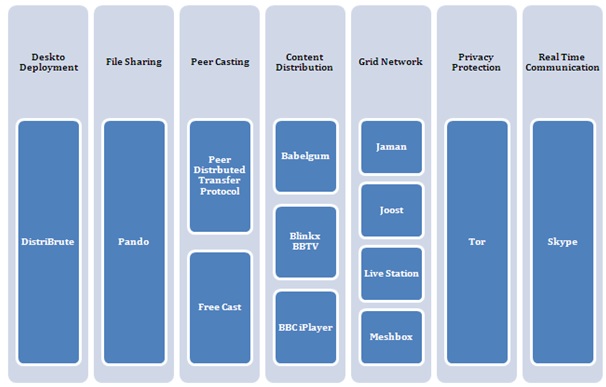P2P Live Streaming Projects.
P2P is nothing but peer to peer system, P2P live streaming projects don’t need any specific IP multicast or the infrastructures which will distribute the content. P2P live streaming projects chiefly used to pass multimedia files promptly from one host indeed to multiple servers. P2P or peer to peer system can either send or receive a file successfully on the session time basis. P2P projects are very able or capable than any other connection types indeed. As to several chunks, peer to peer communication can divide the request of the input file and consecutively TCP connection is created as with many hosts for the sake of the speedy data passing or transmission. P2P live streaming projects do use the overlay construction that is used to organize all the peers in a network based on some specific characteristics. Chief aim of these P2P live streaming projects is to determine low at all the multimedia content should be transferring lot of the peer system through the overlay structure.
Aim of P2P live streaming projects.
- To develop the multimedia file quality.
- To transform the file speedily.
- To develop certainly the multimedia contents scalability.
- To utilize the resource effectively while transferring, processing and timely developing the files.
- To develop the service quality.
- To reduce at all the single servers workload.
- To support assuredly the heterogeneity and symmetry access of indeed the bandwidth.
- To change the location of the peer energetically for the sake of efficient as well as effective multimedia transformations.

Classification of p2p live streaming Projects.
Peer to peer system is sorted out on the overlay topology basis. Peer to peer live streaming have the structures such as tree based, mesh based and hybrid based.
Tree based Live Streaming.
The P2P system, after forming itself as a tree to lead all the peer system, can divide the absolutely original multimedia file streaming into several sub stream files. The P2P system can travel these sub system files from the parent tree peer to all the eager or interested peers. The limitations like maintaining the several tree structures are there still in this tree based structure. Further limitations are there such as deliver rate of the content is very high, minimum throughput only amidst the file uploading phase and the apt numbers of resources are not at all utilized efficiently.
Mesh based Live Streaming.
This system can connect all the peers at random into an overlay network and can use rather the push and pull based applications for the sake of data transmissions. In order to overcome the limitations of the tree structures mesh based applications have been developed. With fault tolerant technique or mechanism, the P2P researchers can provide the mesh based P2P streaming methods very successfully. This method can back up the logical networks that are decentralized which can accept DNS information of the internet, scientific information, or large data based information to obtain the scalability parameter. OCTOSHAPE, PPLIVE, ZATTOO, PPSTREAM, QQLIVE and TRIBLER are absolutely based on this mesh structure indeed.
Hybrid based Live Streaming.
- In order to obtain better quality services, this system can combine mesh and tree based networks together for an advantage.
- P2P protocols administrated in internet:
- Bittorrent is used for the purpose of file sharing via internet and also for calculating the sum of traffic happened in the internet.
Terminology administered in P2P live streaming.
Technical terms such as chunks, video streaming, channel, peer protocol, pull, push and trackers are very often used indeed in these projects.
Chunks: The data absolutely original and can be divided into such blocks of equal size. These blocks can be many.
Video streaming: Video files can be passed through TV channels to provide live shows or broadcastings in P2P streaming applications.
Peer protocol: This is a set of rule or regulation which a peer system should follow, which controls and signals the interaction amidst peers.
Pull: It is nothing but the function which sends the multimedia content to the receiver peers from the source and the eager child peers only initiate this function.
Push: It is nothing but the reverse action of pull.
Trackers: Node as this can watch the transmitted multimedia file vigilantly using tracker protocol for to communicate with the other peer systems.
Applications Area of Live Streaming Projects.
Movies are downloaded and as also uploaded via bittorrent. Bittorrent can without fail distribute the articles or contents of an article or a content publisher into multiple hosts at a least cost. Hence, an article or content publisher gladly can choose the bit torrent for publishing his or her content via internet. Bit torrent domain can be used by music sharing portals.
Advantages of p2p live streaming projects.
- More reliable.
- There is no need for full-time system administrator.
- Easy to install.
- All the resources and contents are shared by all peers.
- Low cost for building and maintaining the network.
Implications present in live video streaming.
- Media quality.
- Timeliness of stream reception.
- High QoS.
- Bandwidth.

